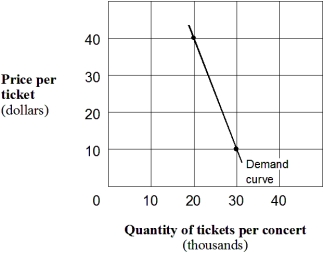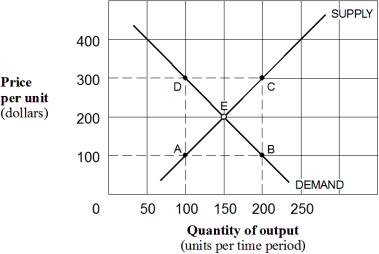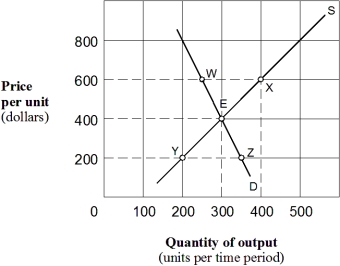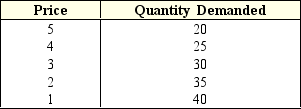A) not be successful if the demand curve slopes downward.
B) be successful if demand is elastic.
C) be successful if demand is inelastic.
D) be successful if supply is elastic.
E) be successful if supply is inelastic.
G) B) and C)
Correct Answer

verified
Correct Answer
verified
Multiple Choice
A public transit company finds that when it reduces the price of a bus ticket,total revenues remain the same.One can conclude from this that:
A) the demand curve is horizontal, reflecting infinite price elasticity.
B) the company sells the same number of bus tickets both before and after the price change.
C) the demand curve for bus tickets must have shifted to the right.
D) the firm is operating in a range of the demand curve that is unit elastic.
E) the price should be lowered further so that a larger quantity can be sold.
G) A) and B)
Correct Answer

verified
Correct Answer
verified
Multiple Choice
Demand sensitivity depends on all of the following except:
A) how low is the price of the good.
B) the sensitivity of firms' output to changes in its price.
C) the consumer's income.
D) the availability and closeness of substitutes.
E) the amount of time a consumer has to adjust to price changes.
G) C) and D)
Correct Answer

verified
Correct Answer
verified
Multiple Choice
Exhibit 5-7 Demand curve for concert tickets
 -In Exhibit 5-7,if promoters raise their prices from $10 to $40 per ticket,then their total revenue will:
-In Exhibit 5-7,if promoters raise their prices from $10 to $40 per ticket,then their total revenue will:
A) increase.
B) decrease.
C) remain unchanged.
D) react unpredictably.
F) B) and D)
Correct Answer

verified
Correct Answer
verified
Multiple Choice
Which of the following statements is true?
A) b and d.
B) Total revenue is maximized when elasticity is one.
C) Goods are said to be price inelastic when the elasticity is greater than two.
D) Demand for milk is more elastic than demand for football tickets.
E) Demand for 5-cent candy is more elastic than demand for sweaters.
G) C) and D)
Correct Answer

verified
Correct Answer
verified
Multiple Choice
If Pete raises his price of muffins from $2 to $3 and his sales revenue increases from $35,000 to $38,000,then:
A) the demand for Pete's muffins in this range is price elastic.
B) the demand for Pete's muffins in this range is price inelastic.
C) the demand for Pete's muffins in this range is unit elastic.
D) the percentage change in quantity demanded must exceed the percentage change in product price.
E) this is impossible since this would violate the law of demand.
G) A) and D)
Correct Answer

verified
Correct Answer
verified
Multiple Choice
Suppose that a jewelry store found that when it increased prices by 10 percent,sales revenue increased by 3 percent.Which of the following is true about the price elasticity of demand for the store's goods?
A) Demand is perfectly inelastic.
B) Demand is inelastic, but not perfectly.
C) Demand is unitary classic.
D) Demand is elastic, but not perfectly.
E) Demand is perfectly elastic.
G) A) and E)
Correct Answer

verified
Correct Answer
verified
Multiple Choice
Exhibit 5-9 Supply and demand curves for good X
 -As shown in Exhibit 5-9,the price elasticity of demand for good X between points E and B is:
-As shown in Exhibit 5-9,the price elasticity of demand for good X between points E and B is:
A) 3/7 = 0.43.
B) 7/3 = 2.33.
C) 1/2 = 0.50.
D) 1.
F) B) and C)
Correct Answer

verified
Correct Answer
verified
Multiple Choice
If a revenue-maximizing firm is told that the price elasticity of demand is equal to one,it should:
A) raise prices 1 percent.
B) lower prices 1 percent.
C) raise prices until the elasticity becomes very high.
D) keep the price where it is.
E) lower prices until the elasticity becomes very high.
G) A) and C)
Correct Answer

verified
Correct Answer
verified
Multiple Choice
Exhibit 5-8 Supply and demand curves for good X
 -As shown in Exhibit 5-8,the price elasticity of demand for good X between points E and Z is:
-As shown in Exhibit 5-8,the price elasticity of demand for good X between points E and Z is:
A) 3/13 = 0.23.
B) 13/3 = 4.33.
C) 1/3 = 0.33.
D) 1.
F) B) and D)
Correct Answer

verified
Correct Answer
verified
True/False
If the price elasticity of demand coefficient equals 2,this means a 10 percent increase in price will result in a 20 percent decrease in the quantity demanded.
B) False
Correct Answer

verified
Correct Answer
verified
Multiple Choice
If an increase in the price of a product from $1 to $2 per unit leads to a decrease in the quantity demanded from 100 to 80 units,then according to the averaging equation,the value of price elasticity of demand in absolute terms is:
A) 0.33.
B) 2.33.
C) 0.25.
D) 3.
E) 0.66.
G) A) and E)
Correct Answer

verified
Correct Answer
verified
Multiple Choice
Suppose the president of a college argues that a 25 percent tuition increase will raise revenues for the college.It can be concluded that the president thinks that demand to attend this college is:
A) elastic.
B) inelastic, but not perfectly inelastic.
C) unitary elastic.
D) perfectly elastic.
F) A) and C)
Correct Answer

verified
Correct Answer
verified
Multiple Choice
The price elastic portion of the linear demand curve lies:
A) b and c.
B) above the point of unit elasticity.
C) anywhere to the left of current market prices.
D) below the point where total revenue is maximized.
E) at the intersection with the supply curve.
G) C) and D)
Correct Answer

verified
Correct Answer
verified
Multiple Choice
Exhibit 5-2 Price and quantity demanded data
 -Using Exhibit 5-2,what is the price elasticity of demand when the price falls from five dollars to four?
-Using Exhibit 5-2,what is the price elasticity of demand when the price falls from five dollars to four?
A) 1.
B) 1.25.
C) 0.8.
D) 2.0.
E) 0.4.
G) B) and D)
Correct Answer

verified
Correct Answer
verified
Multiple Choice
The price elasticity of demand coefficient for a good will be greater:
A) if close substitutes exist.
B) if minor complements exist.
C) in the short-run.
D) if a small portion of the budget will be spent on it.
F) A) and C)
Correct Answer

verified
Correct Answer
verified
Multiple Choice
If the demand for cigarettes is highly inelastic,this indicates that:
A) higher cigarette prices will increase the demand for cigarettes.
B) the price elasticity coefficient of cigarettes exceeds 1.
C) the price elasticity coefficient of cigarettes equals 1.
D) the quantity of cigarettes purchased by consumers is not very responsive to a change in the price of cigarettes.
F) A) and B)
Correct Answer

verified
Correct Answer
verified
Multiple Choice
When a 2 percent increase in price generates a greater than 2 percent decrease in quantity demanded,then:
A) demand is price inelastic.
B) total revenue increases.
C) demand is positively sloped.
D) demand is unit elastic.
E) total revenue
G) A) and B)
Correct Answer

verified
Correct Answer
verified
Multiple Choice
The longer the time period under study,
A) the more elastic is the price elasticity of demand.
B) the less sensitive consumers will be to price changes.
C) the less adjustment consumers will make to price changes.
D) the more inelastic is the price elasticity of demand.
E) the more likely any given price cut will result in a smaller reaction by the consumer.
G) A) and E)
Correct Answer

verified
Correct Answer
verified
Multiple Choice
If the percentage change in the quantity demanded of a good is less than the percentage change in price,price elasticity of demand is:
A) elastic.
B) inelastic.
C) perfectly inelastic.
D) unitary elastic.
F) All of the above
Correct Answer

verified
Correct Answer
verified
Showing 61 - 80 of 177
Related Exams